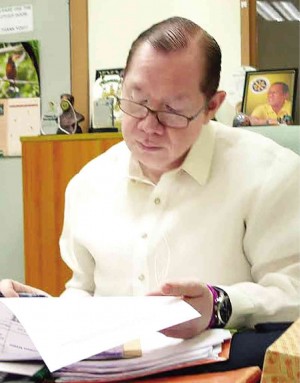
ASIDE from ensuring Filipino senior citizens are properly immunized and mobile, Eric Tayag is also supporting a bill that would provide mandatory Philippine Health Insurance Corp. (PhilHealth) coverage to all senior citizens, whether indigent or not.
Senior citizens spending too much of their time being inactive—viewing television, social networking via computer, and sitting or lying down—are facing a lot of health risks.
“They’re paying a high price for their inactivity, with higher rates of heart disease, obesity, osteoporosis and even early death compared with the general population,” said Assistant Health Secretary Eric Tayag during last Wednesday morning’s Walk for Life parade that ushers in the Elderly Filipino Week celebration from Oct. 1 to 7.
Leading hundreds of senior citizens to a dance cum workout at the SM mall of Asia in Pasay City, Tayag further explained that with this year’s theme “Ang Nakatatanda ay Yaman, Katuwang sa Pag-unlad ng Bayan, Pangalagaan Kanilang Kapakanan,’” the event provided registered participants free health services, including bone scanning, random blood sugar testing, cholesterol testing, pneumococcal vaccine shots and medical consultation.
This year, the Department of Health has acquired 1.7 million doses of flu vaccines as well as 1.1 million doses of pneumoccocal vaccines, which will be given for free to poor senior citizens included in the National Housing Targeting System for Poverty Reduction list.
Just a portion
“But this is just a portion of what we intend to provide this week. Other senior citizens, wherever they may be in the country, may just go to the nearest health center or government hospital and avail themselves of the free pneumoccocal and flu vaccine that could protect them from pneumonia and flu infections,” said Tayag.
The doctor estimated that 6.8 percent or 7 million of the population belong to the elderly group (aged 60 and above).
Tayag said: “If they ignore the vaccination, if they don’t stay active, all the things they’ve always enjoyed doing and taken for granted will soon start to become that little bit harder to do. Remember: Physical activity and exercise can help them stay healthy, energetic and independent as they get older.”
It has been recognized for many years that senior citizens are at greater risk of serious complications from flu, a highly contagious viral respiratory tract infection, as well as pneumonia, an inflammation of one or both lungs because they have generally weak immune system or already have underlying health problems.
Strong evidence
Tayag added that there was now strong scientific evidence that people who are active have a lower risk of heart disease, stroke, type 2 diabetes, some cancers, depression and dementia.
He advised the public: “Activities like shopping, cooking or other housework don’t count because the effort isn’t hard enough to increase the heart rate. Physical activity is anything that should get one’s body moving including anything from walking and dancing to engaging in recreational sports. The first thing to bear in mind as you get older is to keep moving so walk fast, ride a bike, play doubles tennis or dance the zumba.”
Research shows that it is never too late to adopt and reap the health benefits from a more active lifestyle—elderly individuals who are active will reduce their risk of heart disease and stroke to a similar level as younger people who are active.
According to Tayag, if one has been inactive for a while, that person should not rush into exercising. He reminded the public: “It’s important to build up activity gradually to reach recommended levels. The biggest benefits come to those who start from scratch, moving from a sedentary lifestyle to a moderately active one—making the biggest difference to your health. The more you do, the greater the health benefits.”